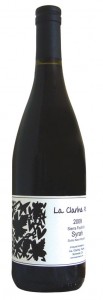Wine Picks – May 2011
Posted on May 3, 2011 – 5:52 AM | by Admin Ametzoi Getariako
Ametzoi Getariako
Txakolina 2009
This tastes like Sprite, if Sprite were bone dry. Which is to say Txakolina, a white wine from the Basque region of Spain, has an intense lemon-lime character, tingles with bubbles, and goes down extremely easily. The indigenous Hondarribi Zuri is the primary grape, blended with just a little of its red cousin, Hondarribi Beltza. Normally, you’d look for the most recent vintage of a wine like this (which would be 2010), but when I saw a bottle of the 2009 at the Sacramento Co-Op on sale for $15.99 I decided to take a chance on its freshness. It was as fresh as wine can be, bristling with energy and a saltiness that brings to mind the coastal setting in which it’s made. The village of Getaria is perched on the north coast of Spain, just down the highway from San Sebastian, and the wine is just perfect for any meal involving simply prepared seafood. Txakolina (also called Txakoli or Chacoli) is part of a stylistic continuum of wines made around the Bay of Biscay: from Muscadet in France down to Vinho Verde in Portugal, these wines all share a briny salt air quality, great acidity, and residual carbon dioxide. As we lead up to the hot summer months, consider Txakolina as your quaffing wine of choice.
 La Clarine, “Sumu Kaw Vineyard”
La Clarine, “Sumu Kaw Vineyard”
2009 Sierra Foothills Syrah
When I read about wine, I read a handful of wine critics who, like me, are generally unimpressed with California wine. That’s why my curiosity was piqued when they all started chattering about a winery making natural wine in the neighborhood of Sacramento. “Natural wine” is a buzz phrase used with increasing frequency to describe wines made with the least amount of intervention possible. The idea being that once the winemaker has gone to the trouble of growing grapes organically or biodynamically (La Clarine is biodynamic), he or she stays out of the way and let the grapes turn themselves into wine that expresses itself more purely than wine made with additives. Most consumers would be surprised at how much intervention takes place at a typical California winery. In fact it’s common for winemakers to add sugars, concentrates, yeasts, acid, oak chips, and sulphur dioxide to mold the wine into something it wasn’t naturally. It should be said that many traditional European wineries add commercial yeast for fermentation and use some sulphur dioxide to preserve the wine in the bottle, and make tremendous wines while doing so. But I admire the aims of the natural wine movement, especially as it applies to California, where wines often taste more like the brand of oak chip used than the grape variety stated on the label. Enter La Clarine, founded ten years ago in Somerset (ten miles southeast of Placerville), and its 2009 Syrah. It smells like dark fruits and earth, indeed it smells like Syrah! Alas, on the palate, the vibrant fruit and minerality was stifled by overly high alcohol; a perennial problem with California wine. Though the grapes are grown at 2900 feet above sea level (twice as high as some of the high acid wines of the Italian Alps), apparently the increased altitude isn’t sufficient to counter the hot weather and create a truly balanced wine. Yet, there is much to like about this wine, and if you prefer the full-bodied California style and want to taste a natural version, pick up a bottle at the Sac Co-Op for $14.99, and pair it with lamb burgers and Roquefort.


